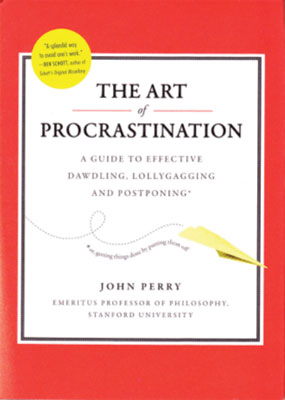Every so often werun across something that brings us up short, persuades us to stop and think, to reconsider, while putting off for later what we really should be doing now. In my case the cause of my putting off and delaying is a little book that arrived in the mail awhile back. It’s small, so it was a fast read. I pondered it for awhile, then set it aside to think aboutlater, while I got on with less important tasks.Now, I’m back, writing this essay about it.Slowly, for there is so much else to do.
The book is ‘The Art of Procrastination: A Guide to Effective Dawdling, Lollygagging and Postponing’, by John Perry, a philosophy professor from Stanford University. The good professor admits openly that he put off completing the tiny tome for several years, while dealing with many less important things. Procrastination happens, however you define it: avoidance, or putting off something to be done, until later..., whatever, whenever.
 One reviewer calls it a “sly volume”. Sly indeed, with profound effects on your psyche.Another reviewer points out that taking the time to read this book is “A splendid way to avoid one’s work.” It’s all about dilly-dallying and killing time, the art of ignoring more pressing responsibilities.This tiny little twerp of a book reveals Why, with wit and humor. And it is tiny—small enough to fit in your shirt pocket, barely a quarter of an inch thick, fewer than 100 pages, printed in a large font with plenty of white space. It’s a quick read, easy to put aside until some opportune time.like now.
One reviewer calls it a “sly volume”. Sly indeed, with profound effects on your psyche.Another reviewer points out that taking the time to read this book is “A splendid way to avoid one’s work.” It’s all about dilly-dallying and killing time, the art of ignoring more pressing responsibilities.This tiny little twerp of a book reveals Why, with wit and humor. And it is tiny—small enough to fit in your shirt pocket, barely a quarter of an inch thick, fewer than 100 pages, printed in a large font with plenty of white space. It’s a quick read, easy to put aside until some opportune time.like now.
Procrastination is what the ancient Greeks called ‘akrasia’. In Nepali it’s ‘tarnu’ or ‘dhil-dhal’(which may well be related to English ‘dilly-dally’).Whatever you call it, it’s about how and why people choose to do something other than what they know is best to do.
But, that’s okay, for Professor Perry’s whole reason in writing the book, he says, isto allow ardent procrastinators to feel good about themselves. Guilt-free.It all revolves around a concept he calls “structured procrastination.” That’s when you find yourself getting a whole lot done—just not the most important things—without feeling guilty. You can read all about it online at www.structuredprocrastination.com. You can even buy aStructured Procrastination T-shirt—clever!—while you should be doing something else.
This perceptive little book also discusses the relationship between Procrastination and Perfectionism, and the notion of being Horizontally Organized. It also addresses the weighty question: ‘Do Procrastinators have to be Annoying?’ And in an Appendix, which he warns you to read at your own risk,Perry describes How to Kick the Habit.
I like the chapter on ‘The Computer and the Procrastinator’, if for no other reason than I am sitting at my computer now, procrastinating in the guise of writing this essay. I have lots to do, but this is more fun.
And I like it where he points out that if you live in Asia and have to submit a memo or a report to someone on the West Coast of North America by a deadline, you can put easily it off until the last minute, then send it by email in time to arrive there a half day before you’ve sent it. Hint: time itself procrastinates by going backward across the International Date Line. On the other hand, something sent from North America to Nepal may arrive‘dilo’ (late) by a half day.
Meanwhile, my advice is to put it off no longer. Stop procrastinating and read this petite primer on how to procrastinate artfully. Then, never feel guilty again.
This clever little book is from Workman Publishing (New York, 2012). Don’t procrastinate: ask your book dealer to order one up for you.










